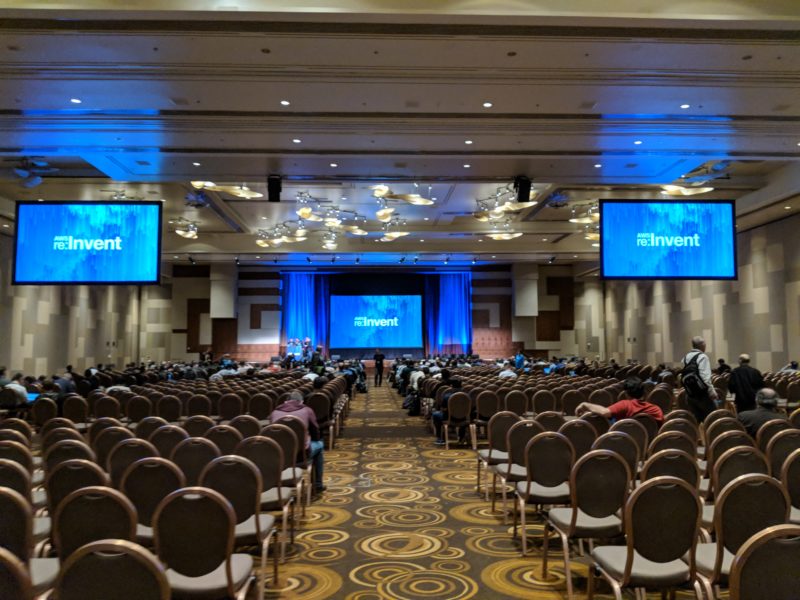Amazon certainly knows how to go big at a conference. With nearly 50,000 attendees AWS re:Invent was spread across Las Vegas hotels and included fully booked sessions from end to end. Over 1000 sessions were held and venues spanned the MGM, Aria, Venetian, LINQ and Mirage elevating conference logistics and unfortunately wait times to a new level.
The conference focused on so many topics related to data analytics and artificial intelligence that it is a challenge to summarize and impossible to catalogue in a brief. Of particular importance were Amazon’s continued support for building and querying data lakes in an ad hoc manner and allowing a pay per query model. Data lakes have been gaining popularity in recent years as a simple way to hold and govern the vast information that businesses used to simply throw away. They facilitate new capabilities by standing by with raw but managed and catalogued data that can be blended into a new dashboard or monitoring systems. AWS revealed more about capabilities like AWS Glue, Redshift Spectrum and it’s Athena service which are all focused on the automatic cataloging of information that is simply stored in their high scale block storage (S3) and then providing ad hoc queries to be run against it.
This is an innovative approach to getting value from data that usually is left on the shelf. I always get looks of awe when I show a utilities or telecommunications company that all of that data they have in cold storage could be queried without any new infrastructure and while only paying by the query and data scanned. It’s a true pay per use model, and the uninitiated have usually accepted long ago that information like that is locked away from easy analysis. AWS continues to advance their tooling to support data lakes, make them simpler to setup and easier and cheaper to analyze.
Repeatedly AWS brought customers up to the stage to show the potential of artificial intelligence and how it was creating success in their businesses. Large businesses like Goldman Sachs came to the stage which would be expected to have a sizable technology agenda, but also surprising use cases came from the UFC which uses artificial intelligence to gauge the status of a fight in real-time and extend its content offerings as a result of those inferences. AWS makes the case that it enables this by providing the infrastructure and tools to experiment with new ideas easily and then the global presence to launch the successful experiments into robust products.
AWS clearly sees the future success of AI involving not just machine learning applications, but also intelligent chatbots and voice interfaces. The same slide came up in various talks which narrated user interfaces over the past few decades as web (90’s), mobile (00’s) and now natural language. During the conference they launched Alexa for businesses, which will extend the product already used at home with capabilities like booking company resources and managing conference calls. Speakers regularly emphasized the development platform created for Alexa skills extension, suggesting that they see themselves as a kind of App Store for new chatbot capabilities. They are opening up their platform for developers to create more applications that are purely driven by natural language and voice interfaces. An exciting development considering how many customer solutions we build on this platform.
Several sessions also focused on computing at the edge, where smaller devices had some cloud compute capability on them so that their functionality could be expanded and their requirement to call back to the cloud to everything was minimized. The discussions shed some light on Amazon’s thinking, they want to be in the smaller devices and support them with their cloud infrastructure. And why not? This would put them leading the wave of IoT applications that is emerging. There are 40 times as many of these smaller devices and if AWS can support them being more intelligent then suddenly they are generating revenue from every thermostat, smoke alarm, vehicle and an endless list of other edge devices.
Andy Jassy (CEO AWS) and Werner Vogels (CTO Amazon) each gave a 2.5 hour keynote. After all, the conference was enormous, the venue’s were vast so marathon keynotes somehow seem fitting. Both keynotes focused on the breadth of what AWS offers over their competitors. More databases, more machine intelligence capabilities, more natural interface tools, more global data centers, more support for business activities and releasing new features at a breakneck speed of 3.5 per day on average in 2017. They focused on the unique scale Amazon offers because that is the competitive differentiator for them over competitors like Microsoft and Google. They scale and then they use that scale to create price efficiency which is the strategy that has led them to be the 800 lb gorilla of the cloud, and the size of their conferences is just one more way they highlight that differentiator.





